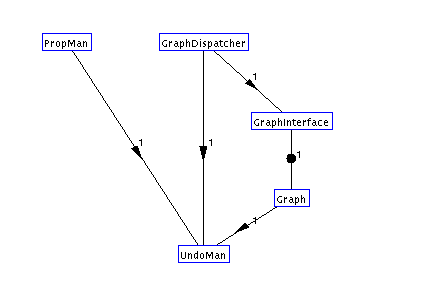Undo Package Implementation Design and Details
Introduction
The undo manager attaches to the structure of the program in several
places. The GraphDispatcher contains the undo manager, and the Graph
and PropMan classes also have a link to it. Each GraphDispatcher (and
its graph) has an undo manager associated with it.
UndoPack object model:

Functionality
Documentation of the specific methods and classes associated with the
undo manager can be found in the
package documentation. The manager
supports unlimited undo (no protection is provided for memory
overflow) and unlimited redo while undoing. That is, you can undo any
number of actions, then redo them immediately. If you undo something,
then do something else, the redo information is lost. There is also a
primitive provision for debugging user-written filters. Normally the
execution of a filter would be considered a single action and would be
completely undone. The filter can place delimiters on the stack of
undo/redo information that will halt the undo process midway, allowing
the user to step through the filter.
Debugging Filters
By calling GraphDispatcher.beginminiUndo() at various points in your
filter, you can place debugging delimiters on the undo stack.
Unfortunately, since the type of the paramter to the filter action
method is a GraphInterface, you must cast the parameter as a
GraphDispatcher before calling this method.
Calls to beginMiniUndo() will not affect the normal execution of the
filter, and the normal undo and redo operations will ignore them. The
only operations that will recognize the mini delimiters are the
miniUndo and miniRedo, which will undo/redo until they encounter a
mini delimiter. Using these tools, you can set "breakpoints" within
your filter, then execute the filter, undo it, and start miniRedoing
to step forward through the execution of your filter.
Implementation
The UndoObject class is the fundamental undoable object. From this
class is inherited a subclass for each undoable action. These objects
are stored in a stack.

